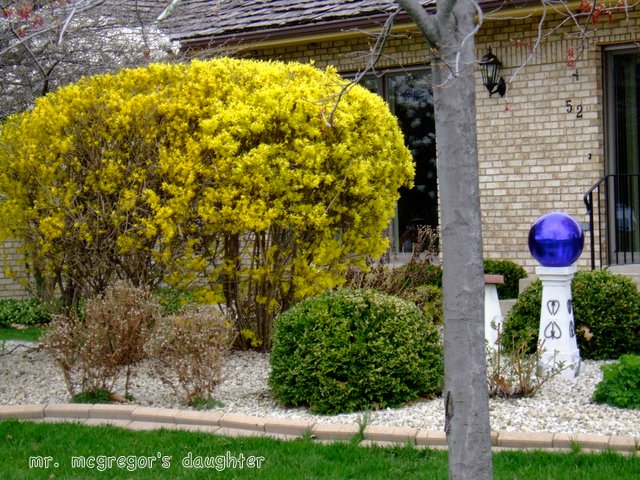
There are people who despise Forsythia, some of them aren't even gardeners. I've come to believe that there are no banal plants, only banal uses of plants. This is why people hate it.

Most people have never seen one in its full glory, instead seeing them only as yellow blobs. (This one was in a yard in a town in Indiana which shall remain unnamed to protect the guilty.)
When not sheared to within an inch of its life, Forsythia is a graceful, arching shrub.

It was named in honor of William Forsythe, so technically, it should be pronounced for-Scythe-ee-uh, but I follow the crowd on this one and pronounce it for-Sith-ee-uh. It's been an outstanding year for the Forsythia. I can't remember ever seeing them look better.

Forsythia has been accused of being a one-trick pony, interesting only when the Daffodils are blooming.

Although I don't have one, there are variegated forms. Granted the plain variety can be a little, well, plain in summer, but mine always displays fall color.

In this photo from last November, it was just starting to turn yellow (as seen in foreground, in background is Calycanthus floridus), before becoming purplish-burgundy. I can't identify my Forsythia, as they were here when I bought the property.
I think my Forsythia look so good this year because they are finally getting full sun. (The big boxelder was cut down last year.) It got very cold here last winter and there was a lot of snow, but my Forsythias are huge (over 10 feet tall), so snow cover isn't the answer (although in 2009, it bloomed only where it was covered by snow). The early onset of warm weather brought them into full bloom very quickly, all the blooms seeming to open at once.
Forsythia x intermedia is hardy to Zone 5 (some cultivars are hardy to Zone 4) and blooms on new wood. Every year, just after it is done blooming, I cut out about a third of the old canes. This allows the shrub to remain graceful and rejuvenated, ensuring blooms for the next year. I don't allow the branches to touch the ground because wherever it touches, it will root and form a thicket. It is drought tolerant, having survived the drought of 2005, and blooms best in full sun.
While there might be better shrubs for spring color in other areas, in the Midwest, it's hard to beat Forsythia as a tough, dependable workhorse.

Just please don't shear it.